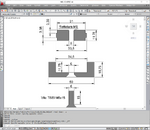Hi
@Angelo Farina et. al,
I'm holding a MK10 with a SPEC cutout and at least one of our measurements differs. Your groove width dimension 11.75mm is different than the unit I'm holding with a width of 11.2mm Therefore if we subtract the ambient hole figure of 5mm then divide by 2 the seal width on each side of the ambient holes you show as 3.38mm should be 3.1mm if I'm measuring correctly.
The i.d. of the seal needs to be small enough to tightly fit the o.d. of the groove. As we are designing a seal, I test fitted a few o-rings to get an idea of a firm seal. The best fit I could find was a -024 which has an (un-stretched) i.d. of 1.114 inches (28.30mm) I think this issue is significant as just measuring the o.d. of the groove will result in a seal that is not tight enough.
I'll have to leave the material selection to you guys, but remember if this seal is will be coming into contact with silicone grease, it cannot be made of silicone as the seal will absorb the oil and distend.
BTW I think Angelo is every bit as capable to evaluate the boots as I am-but I gladly volunteer to be a test subject and proud owner of a few of the finished product.





